Israeli airstrikes targeted a school housing displaced Palestinians in central Gaza on Saturday, resulting in at least 30 fatalities, including several children. This incident occurred as Israeli negotiators prepared to meet with international mediators regarding a proposed cease-fire.
Among the casualties from the girls’ school in Deir al-Balah, taken to Al Aqsa Hospital, were seven children and seven women. The Israeli military claimed it struck a Hamas command center used for directing attacks and storing weapons, a claim Hamas has denied.
Civil defense workers in Gaza reported that thousands were sheltering in the school, which also served as a medical site. Associated Press journalists observed the aftermath, with a dead toddler in an ambulance and bodies covered with blankets amid the rubble of destroyed classrooms.
Gaza’s Health Ministry reported at least 12 additional deaths from other strikes on Saturday.
Officials from the U.S., Egypt, Qatar, and Israel are scheduled to meet in Italy on Sunday to discuss the cease-fire. CIA Director Bill Burns is expected to meet with Qatari Prime Minister Mohammed Bin Abdul Rahman al-Thani, Mossad director David Barnea, and Egyptian spy chief Abbas Kamel.
U.S. officials indicated on Friday that Israel and Hamas have agreed on the basic framework of a three-phase deal. However, Israeli Prime Minister Benjamin Netanyahu, in his speech to the U.S. Congress, vowed to continue the war until achieving “total victory.”
Following the Israeli strike on the school, Nabil Abu Rudeineh, spokesperson for Palestinian Authority President Mahmoud Abbas, stated that Netanyahu’s reception in the U.S. served as a “green light” for Israel to continue its offensive.
A new exchange of fire between Israel’s military and Hezbollah militants in Lebanon heightened concerns about the Gaza conflict potentially sparking a broader regional war.
On Saturday, Israel’s military ordered a new evacuation of a designated humanitarian zone in Gaza in preparation for a planned strike on Khan Younis in the south. This evacuation was prompted by rocket fire that Israel attributed to the area.
The military announced plans for an operation against Hamas militants in parts of Muwasi, a crowded tent camp within the designated zone where thousands of Palestinians have sought refuge. This marks the second evacuation order within a week.
The 60-square-kilometer zone, expanded in May to accommodate those fleeing from Rafah, is densely populated with tents lacking sanitation and medical facilities and has limited access to aid.
Mohammad Jaber, originally displaced from Rafah, expressed his frustration, stating, “This is my ninth or eighth displacement. Every time they tell us to go to an area, and it is unsafe. This time, we do not know where to go.”
The Gaza Health Ministry reported that the evacuation orders have forced at least three health centers to cease operations.
Israel estimates that around 1.8 million Palestinians are currently sheltering in the zone. In November, the military indicated that while the area was not entirely safe, it was safer than other parts of Gaza.
The UN agency for Palestinian refugees (UNRWA) stated that it is challenging to determine how many people will be affected by the latest evacuation order. Juliette Touma, the agency’s director of communications, noted, “These are forced displacement orders,” adding that Palestinians have “very little time to move.”
In central Gaza’s Zawaida, Palestinians mourned seven individuals killed by Israeli airstrikes overnight, including parents with their two children and a mother with her two children.
In the occupied West Bank, the Palestinian Health Ministry reported that an Israeli drone strike in Balata camp, Nablus, killed a 17-year-old and a 24-year-old and wounded 22 others. The Israeli military stated that the strike was a response to fire from militants, resulting in the injury of a soldier.
The conflict in Gaza has claimed over 39,200 Palestinian lives, according to the Health Ministry. The UN estimated in February that around 17,000 children in Gaza are now unaccompanied, a number likely to have increased since.
The war began with a Hamas assault on southern Israel on October 7, allegedly killing 1,200 people, primarily civilians, and taking about 250 hostages. Approximately 115 hostages remain in Gaza, with around a third believed to be dead, according to Israeli authorities.
On Saturday night, Israelis held an anti-government demonstration in Tel Aviv, demanding a cease-fire and the return of remaining hostages. Protester Tamir Guytsabary emphasized the urgency, saying, “There’s a deal on the table and we need to make it happen, and we need to make it happen now.”


